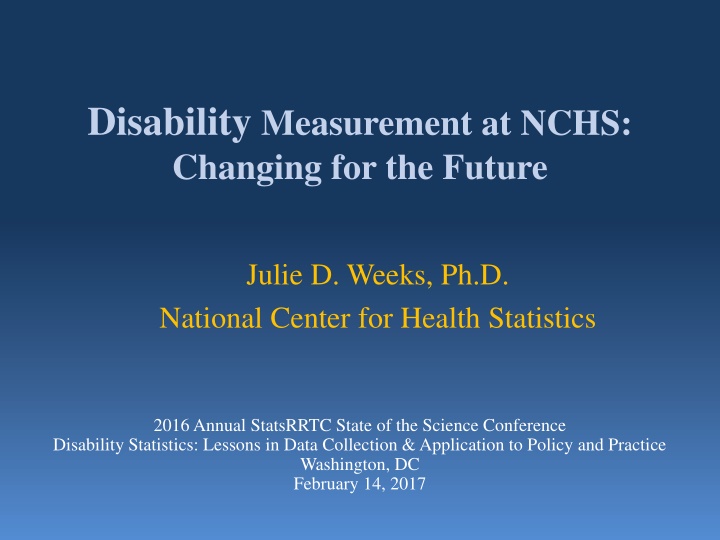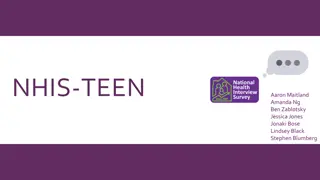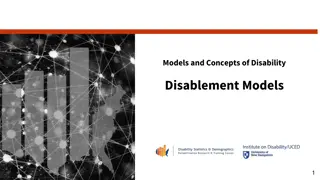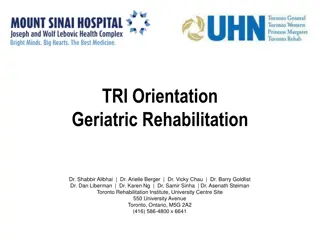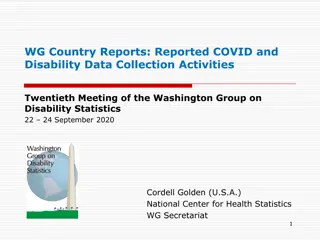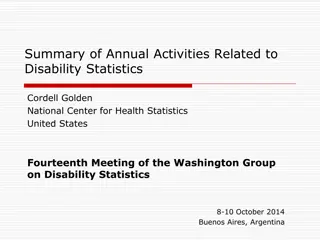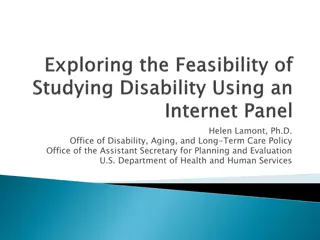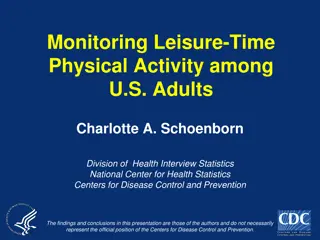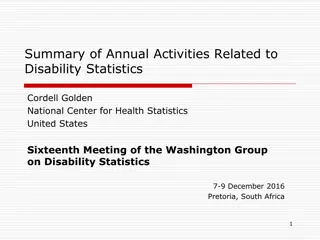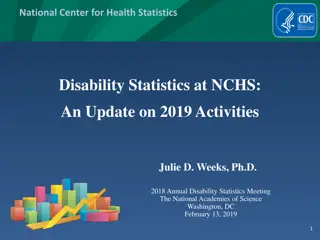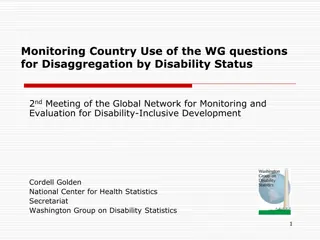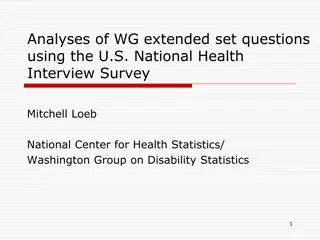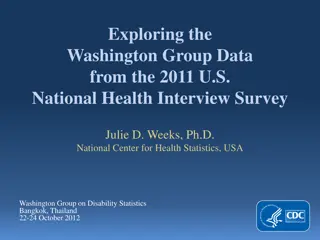Disability Measurement Developments at NHIS: Changing Trends for Better Data
Disability measurement developments at NHIS, including content redesign, future implications, and key roles. NHIS background, purpose, mode of data collection, and key objectives explained. NHIS redesign reasons and the importance of long-term planning are also discussed. Length of completed interviews data presented for NHIS from 2006 to 2015.
Download Presentation

Please find below an Image/Link to download the presentation.
The content on the website is provided AS IS for your information and personal use only. It may not be sold, licensed, or shared on other websites without obtaining consent from the author.If you encounter any issues during the download, it is possible that the publisher has removed the file from their server.
You are allowed to download the files provided on this website for personal or commercial use, subject to the condition that they are used lawfully. All files are the property of their respective owners.
The content on the website is provided AS IS for your information and personal use only. It may not be sold, licensed, or shared on other websites without obtaining consent from the author.
E N D
Presentation Transcript
Disability Measurement at NCHS: Changing for the Future Julie D. Weeks, Ph.D. National Center for Health Statistics 2016 Annual StatsRRTC State of the Science Conference Disability Statistics: Lessons in Data Collection & Application to Policy and Practice Washington, DC February 14, 2017
A number of disability measurement developments National Health Interview Survey (NHIS) Content redesign for 2018 Extensive changes to disability content Measures under consideration for the future Disability statistics: implications to consider
NHIS Background Purpose To monitor the health of the US population through the collection and analysis of data on a broad range of health topics. Sample Address-based, multi-stage, clustered national sample of housing units from every state, to be representative of the civilian noninstitutionalized US population. Mode In-person interviews by Census interviewers, with follow- up by telephone if needed. Data Collection Continuous, with quarterly and annual data files. Sample Size Complete interviews for 35,000+ households annually, about 87,500 persons.
Key Roles for the NHIS Provide objective scientific data for DHHS from a well- established, high-quality, in-person survey on topics including health conditions, health behaviors, health insurance, and health care utilization. Maintain a large sample size for quarterly national estimates and for annual estimates among population subgroups. Maximize stability over time to produce reliable trends. Provide gold standard estimates for federal and private surveys to use for benchmarking and for adjusting estimates.
NHIS Redesign Why redesign? Most recent major content redesign occurred in 1997 Respondent burden increasing and response rates decreasing Why now? Reduce respondent burden and improve data quality Necessary sampling frame redesign in 2016 introduced additional complexity Final measurements for Healthy People 2020 objectives can be completed in 2016 and 2017 Long-term planning can help sponsors target content
Length of Completed Interviews, by Quarter: NHIS, 2006-2015 110 100 90 80 Time in Minutes 70 60 50 40 30 20 Mean Median 10 0 Year and Quarter
NHIS Family, Child, and Adult Response Rates, NHIS 1997-2015 95 90 85 80 Percentage Family module 75 70 Sample Child module 65 60 Sample Adult module 55 50 2003 2014 1997 1998 1999 2000 2001 2002 2004 2005 2006 2007 2008 2009 2010 2011 2012 2013 2015 Year
Criteria for Prioritizing Content Strong link to public health: Leading causes of morbidity/mortality, known risk or protective factors, priority populations at risk, intermediate outcomes Relevant to HHS agency goals: Part of HHS strategic plan, HHS initiatives Needed for long-term monitoring: Leading health indicators High quality measurement: Content can be measured well in household interviews Consistent with other federal surveys: Measure is used by others for calibration, does not duplicate detail collected by targeted HHS surveys Can be estimated reliably with one or two years of data: Less focus on rare conditions or behaviors
Rotating Content How to balance the collection of relevant health content and crucial covariates with respondent burden and funding constraints? Some questions will appear with fixed periodicity, not annually Pros: Less time intensive than asking all questions every year Can still monitor changes in trends with periodic data Cons: Data will not be available annually for all topics
2018 2019 2020 2021 2022 2023 2024 2025 2026 Household Roster - Selection of Sample Adult - Informed Consent The Quilt Health Status - Hypertension - High Cholesterol - Cardiovascular Conditions Asthma - Cancer - Diabetes - Other Chronic Conditions - Height and Weight Difficulties with Vision, Hearing, Mobility, Communication, Cognition, and Self-Care Anxiety - Depression - Social Functioning Annual core content Health Insurance Status and Continuity Financial Burden of Medical Care - Health Care Utilization and Access Annual core Key measures Sociodemographics Prescription Medication - Immunizations Cigarettes and E-cigarettes Marital Status - Veteran Status - Nativity Housing - Schooling - Employment Rotating core Newer topic areas Expanded detail Varying periodicity Family Income - Food-Related Program Participation Telephone Use - Linkage Information Dental, Mental, Other Care Utilization Rotating Conditions Dental, Mental, Other Care Utilization Rotating Conditions Dental, Mental, Other Care Utilization Rotating Conditions Rotating core Mental Health Assessment Employment Detail - Injuries Mental Health Assessment Employment Detail - Injuries Mental Health Assessment Employment Detail - Injuries Sponsored supplements Sustaining sponsors 1- or 2-year modules 5 min or less Chronic Pain - Preventive Services Chronic Pain - Preventive Services Chronic Pain - Preventive Services Chronic Pain - Preventive Services Chronic Pain - Preventive Services Health Behaviors Health Behaviors Health Behaviors Health Behaviors Sustaining Sponsors Content from sponsors that commit to supplements every year Sponsored content 1-year supplements 1-year supplements 1-year supplements 2-year supplements 2-year supplements 2-year supplements 1-year supplements 1-year supplements 1-year supplements 2-year supplements 2-year supplements 2-year supplements 1-year supplements 1-year supplements 1-year supplements 1-year supplements 1-year supplements 1-year supplements 1-year supplements 1-year supplements 1-year supplements
2018 NHIS: Proposed Core Modules Sample Adult Core Self-response (unless unable) Relevant family-level data Fielded with fixed periodicity Demographics, some family relationships, and family income; Health insurance, utilization, conditions, and behaviors Sample Child Core Knowledgeable adult responds for child Relevant family-level data Fielded with fixed periodicity
2018 NHIS: Impact of Module Approach Shifting content from collection in family module to collection in sample adult and/or sample child modules Changes in: Salience: Gets to the health questions quickly Basicdemographics: Collected on all household members Demographic detail: Collected for sample adult and sample child Person-level sample size: Limits utility of rare event questions Respondent for adult health status and disability: From proxy to self Respondent for demographics and insurance: From family respondent to sample adult
Redesign Timeline Background Research Identify and Engage Stakeholders Technical Expert Panels Public Feedback and Comment Secure Sponsorship Develop Questionnaire Content Finalize 2018 Questionnaire System Development and Testing Launch New Questionnaire 2015 2016 2017 2018
NHIS Disability Content Before redesign: ADLs IADLs Basic Actions Difficulties Complex Activity Limitations Personal Care ACS Set WG Short Set WG Extended Set Work Limitation Social Activity Limitation Participation Limitation Age of onset After redesign: WG Short Set WG Extended Set Work Limitation Social Activity Limitation Participation Limitation WG-UNICEF Child Module
WG Question Sets Milestones Short Set on Functioning (6 questions): Adopted in 2006 Added to 2009 NHIS Adopted as the international standard for disability measurement for the 2020 Round of Censuses by UN and UNECE Implemented in surveys and censuses internationally, including DHS Used to monitor the CRPD and the SDGs Extended Set on Functioning (additional functional domains): Adopted in 2010 Added to 2010 NHIS Module on Child Functioning and Disability Developed in collaboration with UNICEF Adopted in 2016 Added to 2018 NHIS Module on Inclusive Education Under development
WG Extended Set on Functioning International standard Greater detail than ACS Additional questions in these domains: Hearing Cognition Mobility Additional functional domains: Communication Upper body Affect (anxiety and depression) Pain Fatigue Four-category response options
WG-UNICEF Child Functioning Module A survey module specifically designed to capture functioning for children 2-4 and 5-17 years. Emotions (Anxiety and Depression)+ + Controlling Behaviour Focusing Attention / Concentrating+ + Coping with Change+ + Relationships+ + Playing* Seeing Hearing Mobility Self-care+ + Fine Motor* Communication Learning (and Remembering+ +) * Domains specific to those 2-4 years of age + + Domains specific to those 5-17 years of age
WG-UNICEF Module on Inclusive Education Purpose To address the association between environmental barriers and school participation. Proposed content Attitudes: societal and cultural norms; perceptions and attitudes of parents, other students and school staff School Environment: physical and academic accessibility Affordability: fees, costs, and competition for resources associated with attendance Out of school: reasons why a child may be out of school
Disability Statistics from the NHIS Inform Departmental and Federal disability-related activities. Health, U.S.: Historically, used limitation of activity due to a chronic condition In 2009, moved to Basic Actions Difficulties and Complex Activity Limitation Disability from NHIS now used as a demographic in 20+ tables (pain, SRH, alcohol use, no usual source of care, health care visits, insurance, etc.) Healthy People Include in the core of all applicable Healthy People 2020 population data systems a standardizedset of questions that identify people with disabilities. Adopted ACS as the standard measure of disability for 2020 work 27 HP objectives on disability; 126 objectives using disability as a demographic Ongoing Research to Inform Change Transition from ACS to WG Identification of special populations (e.g., DD, program eligibility/receipt)
Gathering NHIS Redesign Input Public comment Federal register notice (Spring 2017) NCHS website (on-going) NHIS Web Page http://www.cdc.gov/nchs/nhis.htm NHIS Listserv http://www.cdc.gov/nchs/products/nchs_listservs.htm
